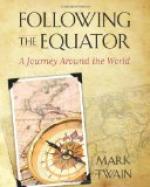Hobart has a peculiarity—it is the neatest town that the sun shines on; and I incline to believe that it is also the cleanest. However that may be, its supremacy in neatness is not to be questioned. There cannot be another town in the world that has no shabby exteriors; no rickety gates and fences, no neglected houses crumbling to ruin, no crazy and unsightly sheds, no weed-grown front-yards of the poor, no back-yards littered with tin cans and old boots and empty bottles, no rubbish in the gutters, no clutter on the sidewalks, no outer-borders fraying out into dirty lanes and tin-patched huts. No, in Hobart all the aspects are tidy, and all a comfort to the eye; the modestest cottage looks combed and brushed, and has its vines, its flowers, its neat fence, its neat gate, its comely cat asleep on the window ledge.
We had a glimpse of the museum, by courtesy of the American gentleman who is curator of it. It has samples of half-a-dozen different kinds of marsupials—[A marsupial is a plantigrade vertebrate whose specialty is its pocket. In some countries it is extinct, in the others it is rare. The first American marsupials were Stephen Girard, Mr. Aston and the opossum; the principal marsupials of the Southern Hemisphere are Mr. Rhodes, and the kangaroo. I, myself, am the latest marsupial. Also, I might boast that I have the largest pocket of them all. But there is nothing in that.]—one, the “Tasmanian devil;” that is, I think he was one of them. And there was a fish with lungs. When the water dries up it can live in the mud. Most curious of all was a parrot that kills sheep. On one great sheep-run this bird killed a thousand sheep in a whole year. He doesn’t want the whole sheep, but only the kidney-fat. This restricted taste makes him an expensive bird to support. To get the fat he drives his beak in and rips it out; the wound is mortal. This parrot furnishes a notable example of evolution brought about by changed conditions. When the sheep culture was introduced, it presently brought famine to the parrot by exterminating a kind of grub which had always thitherto been the parrot’s diet. The miseries of hunger made the bird willing to eat raw flesh, since it could get no other food, and it began to pick remnants of meat from sheep skins hung out on the fences to dry. It soon came to prefer sheep meat to any other food, and by and by it came to prefer the kidney-fat to any other detail of the sheep. The parrot’s bill was not well shaped for digging out the fat, but Nature fixed that matter; she altered the bill’s shape, and now the parrot can dig out kidney-fat better than the Chief Justice of the Supreme Court, or anybody else, for that matter—even an Admiral.




